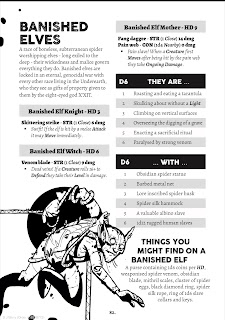These are worth their weight in the precious metal of your choice. In order for an entry on a random table to have significant value it must be something that the GM couldn’t just make up on the spot. So if entry 23 on your Open Country encounter table is “2d6 Peasants,” it’s not working hard enough.
The way the Black Hack handles this is interesting, and I expect it’s not the only example of this. It gives each monster entry two small (d6) tables of what they’re doing and what with. See Banished Elves above. This way we’re not just getting “2d6 Banished Elves, fight ‘em” as a result. You could argue that the old school reaction roll helps add variety to general tables and I would agree and wholeheartedly encourage you to use them.
Now, don’t get me wrong, sometimes you need something general but random in order to introduce an element of chaos (with a small c) into your highly structured plan for this evening’s fun. If high structure fun is your and your group’s bag. I always roll on my “What’s Complicating Tonight’s Grim North Session?” table for this very reason. And despite my preference for more detailed and setting relevant results in general, this is just a big list of potential antagonists. This works for me in that it often throws in an unforeseen or incongruent yet possible wrinkle into a session or scenario. The advantage here being that it can be easy to get drawn into George RR Martin thinking when quickly crafting hooks and scenarios. By this I mean too thematic. When travelling George’s Seven Kingdoms you will often encounter the Fisher Folk who are ruled by the Fish King and sit upon the Cod-bone Throne or whatever. This sort of theming is useful in differentiating between lots of what would be otherwise broadly similar places. Indeed the Districts of Nox Aeterna are themed in this way for that exact reason. However, if we’re stealing a minority religious item from a cult and there are other thieves, other cults and the Watch involved then that’s fine but it’s all a bit obvious. If we roll on our random complication table and the mysterious Lamprey Men are now in the mix then we’ve got to get creative and that’s where the adventure is.
If we look at a more specific example from my setting, each District of the city has a short random encounter table. They’re usually just a d6 but the encounters on them are relevant to that location in some way that I don’t have to just make up on the spot. So generally if I roll that table I get something specific to the region of the city the PCs are travelling through without having to really reference any deeper notes on the area; and it’s automatically congruent with that District and it’s inhabitants. In this instance when I create entries for these tables they include the activity taking place. So for instance if we consider this entry for Rivershore, a gentrified former fishing locale now popular with hipsters:
- Earnest youths seeking monthly charitable donations for blind, mute, plague ridden orphans
So yes, they’re beggars but more in the vein of the modern tabard wearing charity muggers that accost you in London claiming to want just a minute of your time (and of course a monthly direct debit from which their commission is generated.) It’s not creative genius but it’s definitely better than “2d4 beggars,” and that is sufficient for these purposes.

No comments:
Post a Comment